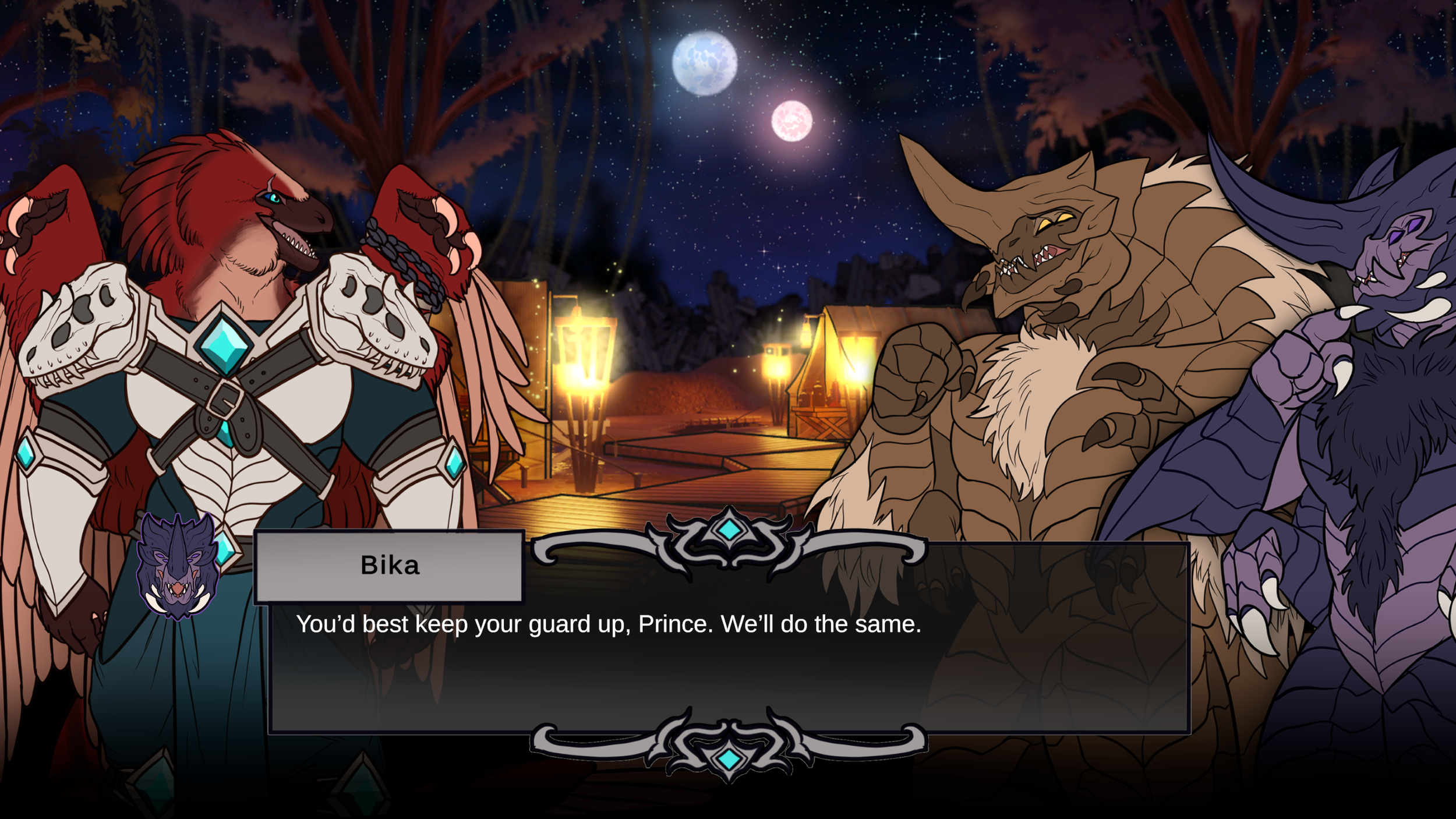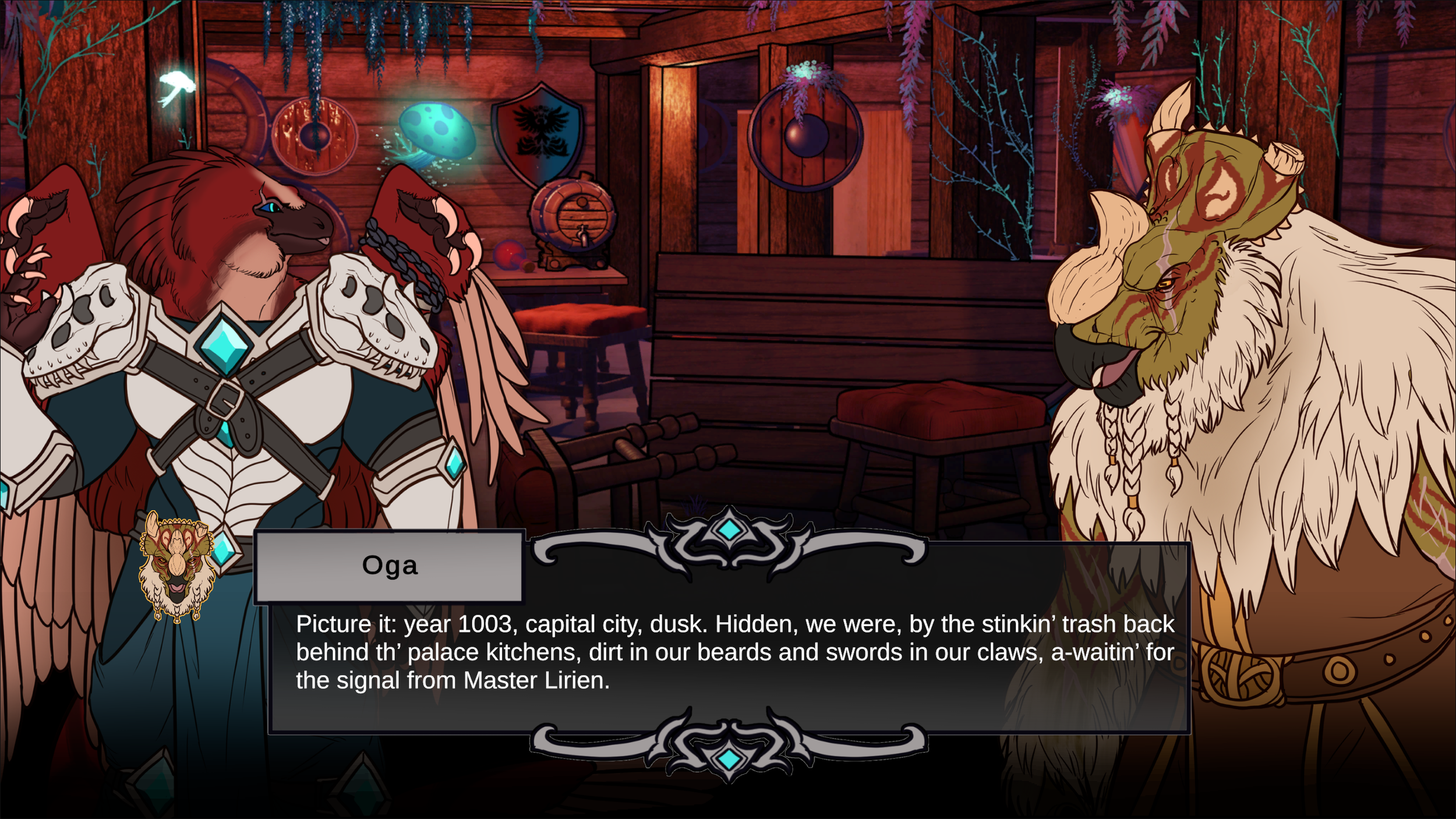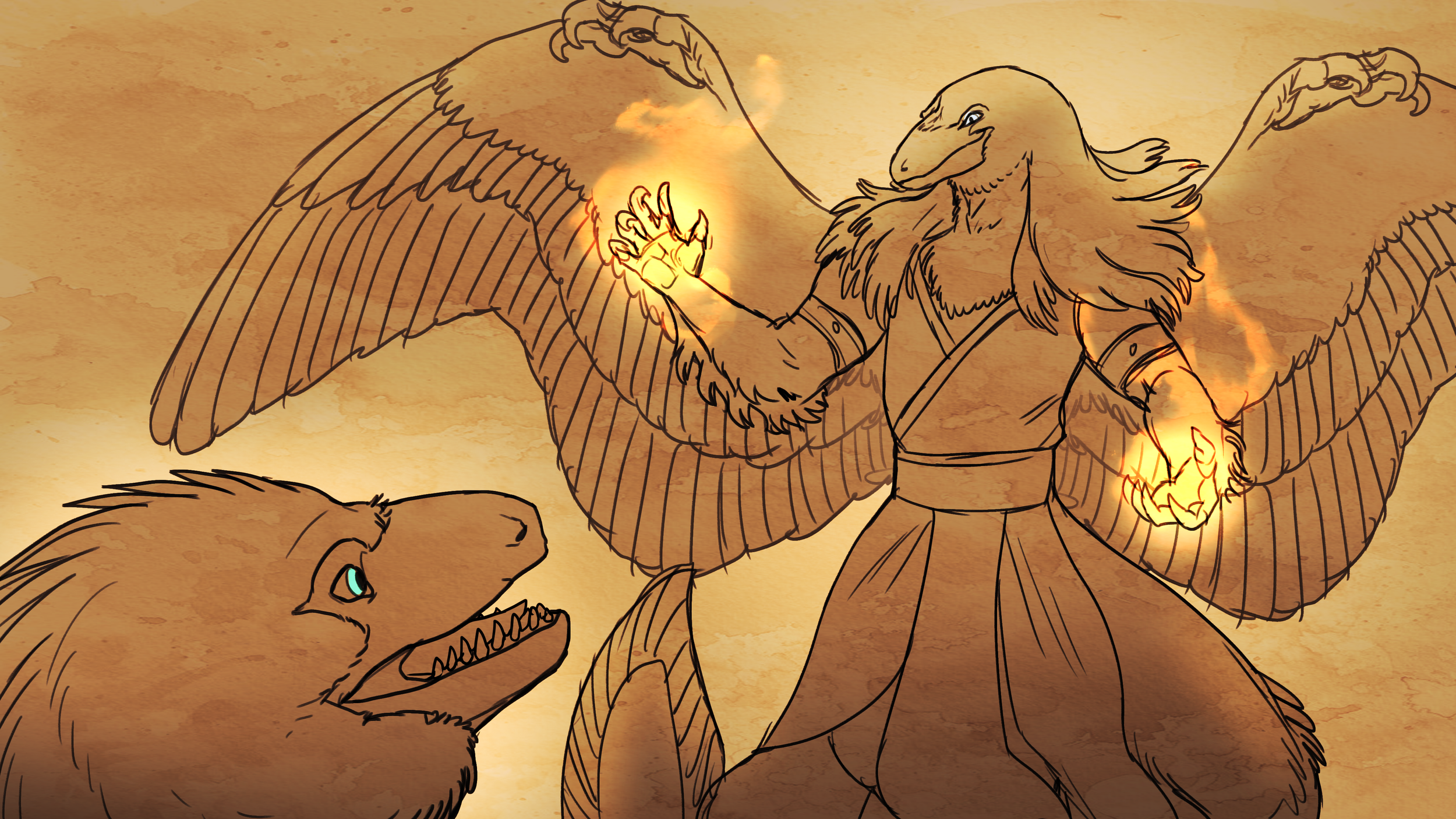Tethia Asunder
Play the Game here.
My Role: Narrative Designer, Primary Editor, Storyboarder
Tools: Google Docs, Ink, Procreate
(The final project was completed in Unity.)
Blight has consumed the kingdom of Tethia, and the only one who can stop it is Prince Tahiri.
Returning to his kingdom after a failed quest, the battered Prince Tahiri finds that the mysterious, harrowing Blight he sought to fix has completely decimated his land. As if that wasn't bad enough, his brother Tahuun is missing, a great beast named Mercius is snatching survivors, and his subjects are none too pleased with his extended absence. To heal Tethia, he must fight his way past the monsters terrorizing his people, solve the mystery of the Blight, and win back the trust of his citizens — if their snide comments don't get him first!
The player follows Tahiri as he battles the Blight, investigates the disappearance of his brother, and interacts with a medley of colorful, opinionated Tethian denizens.
Gameplay: Tethia Asunder has two main play modes: dialogue and runner. In the running sections, the player must dodge obstacles to eventually reach and defeat the boss (Mercius) by memorizing sequences of keys and entering them correctly. The dialogue sections function like a visual novel, with relevant cutscenes sandwiching the gameplay portions and then a point-and-click area where they can interact with other NPCs before progressing. I worked on the NPC interactions and cutscenes.
Objectives:
Create an engaging narrative in a gameplay genre that doesn’t often have one
Write compelling, distinctive dialogue for all NPCs
Craft a deep emergent world and convey it almost entirely through dialogue

Cutscene

Running

Boss fight

Dialogue

Point and click
My Role
I served as a Narrative Designer and the Primary Editor for Tethia Asunder, a six month long portfolio project by our 22-person team of GDC Conference Associates. Along with my two cowriters Sai Mandil and Cato Emerson, I was responsible for:
The overarching story and world. Creating Sauronia, the world in which Tethia Asunder takes place, was a monthlong process, and the story outline, villain, and premise went through numerous iterations.
Distinct dialogue for 9 NPCs. Each writer was responsible for a group of NPCs across the three main locations of the game (forest, city, castle) to keep their voices internally consistent and have creative control over their small scenes. All of us cowrote Tahiri, the player character.
Copy and content editing. I gave continuous feedback to my team of writers on the content of the script as we went, making sure we were all on the same page with the story’s direction. When the script was finalized, I copyedited and polished it before release.
Storyboards. I sketched and laid out most of the story’s cutscenes for cowriter and 2D artist Cato Emerson.
Soliciting and collecting feedback from beta readers. I coordinated 10 beta readers across three iterations of the script, compiled their feedback, prioritized which points were worth incorporating, and made edits based on their critiques.
Challenges
-
Tethia Asunder was both the largest team I’d ever worked on and the only one so far in which I was not the sole writer. Though I took the lead for much of the story, Tethia Asunder was very much a cowritten project. Because the project did not have a hierarchy, with one person guiding the story’s vision, most story decisions we made were discussed in the group until we reached consensus to avoid a “too many cooks” scenario.
For the most part, this went smoothly; our combined excitement about the project made us eager to collaborate, and nobody on our team was prone to defensiveness or hostility towards the others. Sometimes, though, it was difficult to prioritize, especially when elements needed to be cut for scope or edited down. For instance, the NPC Zul was initially a very minor character. He was optional to interact with and basically existed to provide flavor and depth to the story, like Fauwke or Tubi. However, one of our three writers became very attached to Zul and wanted him to become a larger part of the narrative, including an exploration of his deeper backstory with Tahiri and a more extensive conversation. This necessitated shifting the dynamics of the castle NPCs to center Zul more, replacing Alzenius (a royal advisor), who was previously the key NPC in the scene. In the end, centering Zul worked better than our initial plan with Alzenius and facilitated more natural exposition. But it exemplified the risks of a flat hierarchy of writers: we tend to get very attached, and it’s hard to make sacrifices. (Multiple of my NPCs, including a stoned slug and a morose musician, were cut for scope. Ah well, that’s how it goes sometimes!)
-
Sauronia is a place very unlike Earth, and we are three writers who love worldbuilding, as our 40-page world bible attests. The story in the game, however, could only be told in dialogue and art; we did not use in-game documents, external narration, or other sources of lore to communicate details about the world. This challenge came on top of the usual issues with dialogue writing: making it sound natural, avoiding “as you and I both know” monologues, creating distinctive character voices, and so forth.
For this reason, information management — how smoothly we communicated key concepts like Ram and Sill (deific moons), the Moongifted (the magic users in our setting), etc. — was a heavy focus when we sent the script to beta readers. The forms we gave them asked them to specifically describe what they thought these concepts were, and based on how well their responses matched what we intended to convey, we were able to tweak and refine our exposition to ensure the right message came across and that they were understanding the story.
By the end of our editing process, there was very little confusion in our readership. Success!
-
The endless runner genre of game — Subway Surfers, Temple Run, and so forth — usually has incredibly minimal story, just enough to justify why you’re running. As such, we had very little template to work from for Tethia Asunder, and it was also difficult to describe how the runner gameplay and the narrative scenes fit together. In all honesty, I’m not sure they do. The game feels more like a visual novel with random runner sections interspersed than it does a cohesive product. Perhaps part of this is due to the rough-and-ready appearance of the gameplay portions compared to the very polished 2D narrative ones, but I feel the transition from one to the other could be smoother and if I were to repeat this project, I’d keep in closer communication with the technical team to find a better way to do so. In hindsight, much of the narrative work was siloed from the programming, and we could’ve used more cross-team meetings to more deeply understand how our parts fit together rather than simply being two rather disparate halves.
Of course, some of this is a problem of scope, as so many things in games are. If we had time to create more 3D assets or render them more, it would likely feel cohesive. But adding story to an endless runner was always going to be a tall order. I also wish we’d found a way to make the unique memorization mechanic of our gameplay relevant to the story; we could’ve done more thematically with the idea that Tahiri’s weapon is his mind or memory.
-
The saying goes that a picture is worth a thousand words, but it certainly feels as if a word can be worth a thousand pictures, as well — that is, it’s easy for writers to underestimate how many assets their story will necessitate. Our 2D artist, Cato Emerson, was also one of the three writers and helped to give us a reality check, but even he sometimes overestimated the amount of work it would take to, say, complete a cutscene as we’d originally planned it. This led to a thorough schooling in trimming and reducing the art-relevant aspects of the script down to their bare necessities. For instance, six-panel long storyboards would become two or three; characters who’d initially had multiple expressions made do with just one. Staying aware of how much a story will burden the art team — and what aspects are especially scope-ruining — was an important lesson that I will take to future projects.
Some of the scope issues also appeared after it was too late to change the story, namely the rendering of certain 3D assets. Mercius in the finished game is black; he and the other monsters were meant to be orange, and they are referenced as orange in the script. At the time, we had no idea that this would be out of scope, because the scope shrunk due to complications finding 3D artists and creating/implementing renders. (It wasn’t until very last minute that the 3D animations during the running and fighting sequences worked, due to a longstanding bug in the code.) This is unfortunate; maybe someday we will release an update with correct renders.
Below: excerpts from dialogue scenes in different locations




Storyboards
Because I’ve written and illustrated comics for many years, I have a good sense of progression and pacing, especially when it comes to a sequence of still images, as our cutscenes were. Working with Cato, our 2D artist, I took the first stab at outlining and storyboarding most cutscenes. We then cut them back significantly for scope, paring them to their streamlined essentials. My art is very rough, but it worked well enough!
Royal garden flashback: first draft (10 panels)
Royal garden flashback: final draft (5 panels)
Below: Finished flashback cutscene (game version has dialogue)





My Characters
This section contains major spoilers for the game.
Prince Tahiri
Overview: Prince Tahiri of Tethia is the player character of the game. Having failed to find a cure for the mysterious Blight abroad, he returns to Tethia after an extended absence and is dismayed to find his kingdom completely consumed. Upon learning the extent of the problem and the mystery of his missing brother, he hardens his exhaustion into resolve and sets out to save Tethia.
Voice: Tahiri’s character voice is meant to be heroic and a bit grand. He acts his princely role with some formal affectation in front of those he doesn’t know, but in private and among friends, he’s more relaxed and even a little goofy. He cares deeply about his kingdom and is fiercely protective of his brother Tahuun, who somewhat resents this, as Tahiri was raised by their abusive father to be the strong one of the family at Tahuun’s expense. He carries the weight of responsibility and tends to take problems on headfirst, sometimes rashly. He has an open mind and a big heart, even if he can be a bit snappy at times.
Tahiri was jointly written by Sai Mandil, Cato Emerson, and myself.
Forest Location
Glork
Overview: Glork is an old hermit bug who is the first NPC the player meets in the game. Formerly living on his own in the dead of the woods, Glork is now a refugee camped with the rest of the forest characters. He left the camp to search for the bug child Hekta, whom Tahiri rescues from Mercius.
Voice: Glork is grumpy, sour, and highly displeased with Tahiri, whom he thinks ran away from his duties as prince when the Blight hit.
Glork represents the dissatisfaction and betrayal many of Tahiri’s citizens feel about his absence and spurs Tahiri himself to prove them wrong.
Kho & Bika
Overview: Kho and Bika are the adoptive parents of Hekta. They’ve lived in the forest their whole lives and are devastated to see it overtaken by Blight.
Voice: Kho and Bika represent heart and brain, respectively. Kho (brown) is a worrywart, very maternal and highly affected by anything negative that happens to those she cares about. She feels things quickly, deeply, and strongly. Bika (purple) is more reserved and thoughtful, caring in her own way. Where Kho feels panic and unease, Bika feels a grave, heavy grimness.
Kho and Bika appear onscreen together in the forest dialogue cutscene and as an optional conversation in the following point-and-click. Because they’re always together, I count them as one NPC.
Dep
Overview: Dep is the daughter of refugees from Noulweth, an island nation to the north of Tethia, whose parents fled a civil war that ultimately destroyed the country. She is a key character in the forest section of the game, and Tahiri must speak to her to progress. Horrified by the thought of anyone pursuing the powerful relic the queen of Noulweth used to destroy the resistance and decimate the land, she chastises Tahiri.
Voice: Dep is deeply world-weary, bearing the generational trauma that comes from forced displacement from a homeland, and she knows the horror stories of what went on in Noulweth. Her outlook is heavy and sad as she watches Tethia, her family’s new home, teeter on the brink of destruction as well.
Dep also serves to point Tahiri to the next key figure in the narrative, her uncle Oga, whom the player will meet in the city section of the game.
City Location
Oga
Overview: Oga is Dep’s uncle, an elderly Noulwethian who fought against the mad queen as a rebel during the civil war that destroyed their country. A grizzled veteran and gruff grandfather figure with a gallows sense of humor, he’ll tell his war stories to anyone who will listen (and even those who won’t).
Voice: Oga has seen worse, and he’s darkly cheerful about the whole situation, flatly amused by the chaos in a crabby kind of way. (Popeye was an inspiration.) His outrage is more largeness and loudness than anger. When he recounts the destruction of Noulweth, however, he becomes more distant, losing the verve, hyperbole, and clamor that accompanies his normal storytelling.
Oga was my favorite character in the game. He tells Tahiri about the war and sets up the twist villain ending.
Fibiana
Overview: Fibiana is a Moongifted doctor whose student, Venarus, was kidnapped by Mercius. She, along with a group of other refugees, are hiding from the Blight monsters in her wife’s underground tavern.
Voice: Fibiana’s sadness is more a solemn melancholy than outright distress. She outwardly emotes very little and is generally quiet and introspective. When she does speak, she’s is very matter-of-fact and precise in her language to the point of being blunt. Her default state is calm. However, the chaos of the situation weighs on her; as a doctor, it’s doubly difficult to be unable to help.
Fibiana heals Tahiri’s wing in the tavern, which gives him the ability to glide.
Fauwke
Overview: Fauwke is a wealthy socialite who got shunted into the tavern against her will when the monsters attacked. She’s got very little respect for Tahiri and cares mainly about pampering herself over the plight of the other citizens. Her life has been very cloistered and lacking in hardship of any kind.
Voice: Fauwke is haughty, stuck up, and ungrateful. She looks down on the commoners in the tavern and cares about their suffering only to the extent that it prevents her from getting a hot bath and a good preening. She’s always on the verge of rolling her eyes.
Fauwke mostly exists to provide color to the tavern and display the range of NPCs who live in the city normally.
Castle Location
Zadkiel
Overview: Zadkiel is the castle chef, an eternal optimist somewhat lacking in a reasonable sense of self-preservation. Moongifted and brawny, she enjoys weightlifting with the castle guards and inventing new meals. Distress at the lack of good spices in the castle refugees’ hideout led to her near-capture by Mercius in the gardens.
Voice: Zadkiel is cheerful and upbeat, not one to get mired in malaise or what she’d see as pointless misery. Everything about her is big and boisterous, full of energy. She keeps herself busy taking care of the others, sometimes at risk to herself. To her, nothing is worse than someone going hungry.
Tahiri rescues Zadkiel from Mercius, and she gives him a stew in return that boosts his health stats.
Lirien
Overview: Lirien is the twist villain of the game. Trapped by her traitorous sister Selra in a magical amulet during the Noulwethian civil war, she manipulated Tahuun into allowing her to kidnap Moongifted Tethians from across the country in a bid to get her body back by whatever means necessary. Lirien amplified Tahuun’s resentment towards Tahiri until he couldn’t tell truth from lie, gradually controlling his body as well as his mind. Even so, she cares deeply for him in a twisted sort of way. Mercius was her creation.
Voice: Lirien is cold and sneering, gazing out upon the world with a chilly confidence, always in control. She has spent nearly a century justifying to herself why she deserves her body at the expense of others, and her vehemence on this belief is matched only by her determination to see it through. She can be stirred into genuine anger, and she shows flickers of regret and care once defeated. She rarely deigns to raise her voice, but it booms nonetheless.
Tahiri fights Lirien as the final boss. When she’s defeated, Tahuun and the three other Moongifted NPCs she’d sacrificed are restored. All three writers contributed to her writing.



